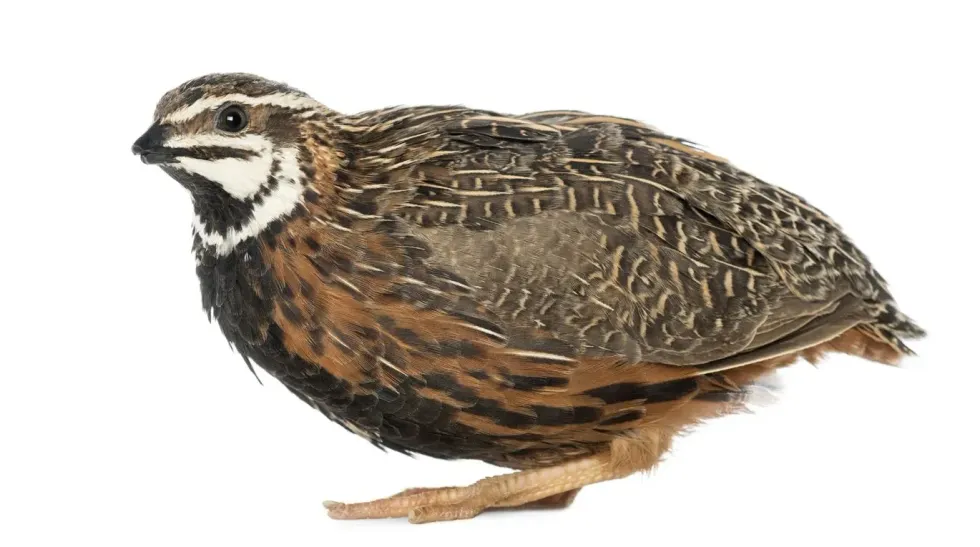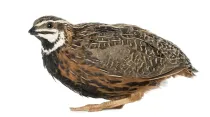A harlequin quail (Coturnix delegorguei) is a fowl bird of the Phasianidae family.
Harlequin quails are native to the African continent, unlike the common quails that are found in most parts of the world. The birds exhibit a color range from russet to dark brown with fewer strokes of black near the chest region and white strokes near the face region.
The main habitat of this bird is the tropical grasslands or the savanna of Africa and the tropical rainforests.
They are found in countries like Kenya, Uganda, Southern Africa, Madagascar, and rarely in a few parts of Arabia.
A harlequin quail makes its nest on the ground, it makes its nest padded with a layer of leaves, grasses, and twigs for cushioning the eggs amidst the shrubs and bushes.
The adult quail performs rituals of mating during the breeding season mainly depending on the timing of rain and the females lay 3-9 eggs on average and the eggs are hidden by them amidst grass and bushes to save them from predators.
Quail are threatened for their meat and eggs, their list of predators includes snakes, raccoons, cats, dogs, jackals as well as human hunters among others.
If you like what you read, do check out falcated duck facts and falanouc facts.
Harlequin Quail Interesting Facts
What type of animal is a harlequin quail?
A harlequin quail (Coturnix delegorguei) is a game bird that is native to the continent of Africa.
What class of animal does a harlequin quail belong to?
A harlequin quail (Coturnix delegorguei) belongs to the class of Aves.
How many harlequin quail are there in the world?
The population of the harlequin quail has not been evaluated due to their increasing population and wide distribution of the species among the remote and unapproachable wildernesses of the African continent.
Where does a harlequin quail live?
A harlequin quail mostly lives in the tropical grasslands and forest regions of central and southern Africa.
What is a harlequin quail habitat?
The habitat of this species of quail is mainly the grasslands of Africa or the savannas and the tropical forests of the continent. The (Coturnix delegorguei) harlequin quail are found in regions namely the countries like Kenya, Uganda, Madagascar, Southern Africa, and parts of South West Arabia.
The female quail birds make their nests on the ground by padding dry leaves and twigs and hiding their eggs amidst grass and shrubs.
Who do Harlequin quails live with?
A harlequin quail generally lives in flocks or coveys; however, harlequin quails are increasingly being domesticated by humans for meat and eggs or are adopted as pets and kept in cages.
How long does a harlequin quail live?
A harlequin quail can live up to 2-3 years on average.
How do they reproduce?
The female harlequin quail starts breeding at the early age of two months. Harlequin quail (Coturnix delegorguei) breeds mainly during spring but their breeding season can occur at other times of the year depending on rain.
Male birds court the females during the breeding season by bringing worms, and insects as gifts as a part of the ritual.
The breeding ritual also involves the exhibition of aggressiveness of the male quail as it chases the female quail, showing gestures of power by puffing its feathers around its neck and unfolding the wings.
The female quail lays about 3-9 eggs within 10-12 days of mating and hide their eggs amidst leaves, shrubs, and bushes to save them from predators.
What is their conservation status?
The harlequin quail is among the least concerned species of birds due to their abundant population among the wild savanna and rain forests. The increasing popularity of quail's meat among humans is also paving the way for their extensive raising of meat and eggs.
Harlequin Quail Fun Facts
What do Harlequin quailS look like?

A harlequin quail is russet in color with a stroke of black near its chest area and light strokes near the face region whereas the females are pale brown and less colorful. A quail has a round and fluffy belly, medium-sized wings, and chicken-like legs.
How cute are they?
A harlequin quail is quite cute and small in size when compared to the other fowl birds of the Phasianidae family and thus these birds can be domesticated quite easily. A harlequin quill is quieter than ducks, geese, and other fowl birds and these features make these birds cuter and a perfect pet.
How do they communicate?
The male quail produces sounds like 'whit-whit' to communicate with the partner and other members of the flock whereas the females make a "chit" "chit" sound as a mode of communication among the flock.
How big is a harlequin quail ?
A harlequin quail weighs about 0.126-0.156 lb (57-71 g) with a body length range of 6.2-7.8 in (16-20 cm). A harlequin quail is similar to other game birds of the Phasianidae family as turkeys, pheasants, and chickens but a quail is quite smaller in size.
A harlequin quail is even less than half the size of an average chicken.
The male of the harlequin quail species is comparatively smaller than those of the species of the new world quails that are native to the regions of North, Central, and South America.
The females of the African species of harlequin quail are quite similar to those of the common quail. A baby harlequin quail can grow very fast, they can become capable of propagating their breed or reproduction at an early age of about 7-9 weeks.
How fast can a harlequin quail fly?
A harlequin quail does not fly very frequently like the birds of flight but the quail of this species can fly at a speed of at least 40 mph (64.3 kph).
How much does a harlequin quail weigh?
A harlequin quail weighs about 0.126-0.156 lb (57-71 g) with a body length range of 6.2-7.8 in (16-20 cm) thus commercially, this bird is not as profitable as other birds like turkey or chicken which are mainly raised for meat and eggs. The Japanese pharaoh quail are extensively raised for their meat as they are the best-tasting breeds.
What are the male and female names of the species?
The male quail of the species is known as a cock whereas the female quail is termed as a hen.
What would you call a baby harlequin quail?
The baby of a harlequin quail is called a chick.
What do they eat?
A harlequin quail is an omnivorous bird. They feed on mollusks like snails, slugs, small insects like beetles, bugs, ants, termites, grasshoppers, caterpillars, bugs, and small worms. They also feed on greens or plant-based food like leaves, grains, seeds, and pulses. The domesticated quail eats corn and millet.
Are they dangerous?
Quail can poison themselves while on their journey of migration and such a quail can cause sickness if eaten by humans; however, this is a rare case and in general, a quail is an extremely harmless and meek animal, its small size and quiet nature is far from posing any threat or danger to humans.
Would they make a good pet?
A quail is a medium-sized bird with a cute round belly and soft feathery body with a color range of dark brown to russet. A quail is quiet and smaller in size when compared to the birds of the same family like ducks and chickens thus making quail a better option as a pet.
Did you know...
An amazing feature of the harlequin quails is the appearance of their eggshells.
Quails often face snakes, foxes, wild cats, and dogs as their predators in the wild savannas.
The predators often steal and eat the egg of the quail.
But nature has its ways as the eggs of the quails are not plain shades of white like the eggs of chickens, rather the egg of a quail has dark patches on the light-colored shell of it which makes the eggs less visible to predators and hence acts as camouflage among the grasses and bushes.
A quail is generally found to make its nest on the ground, however, the natural defensive feature of the eggs keeps them safe from its predators.
What is the smallest breed of quail?
The Chinese painted quail or the button quail is the smallest breed of quail.
What is the largest quail breed?
The bobwhite quail is among the largest breed of quail.
Here at Kidadl, we have carefully created lots of interesting family-friendly animal facts for everyone to discover! Learn more about some other birds including fairy pitta facts or secretary bird facts.
You can even occupy yourself at home by drawing one on our Harlequin quail coloring pages.










